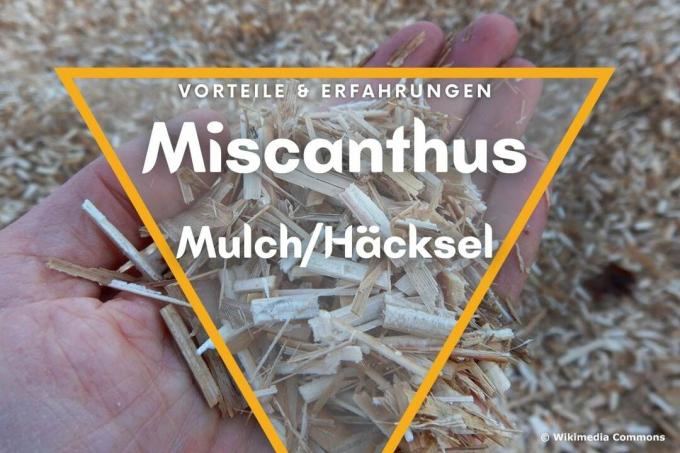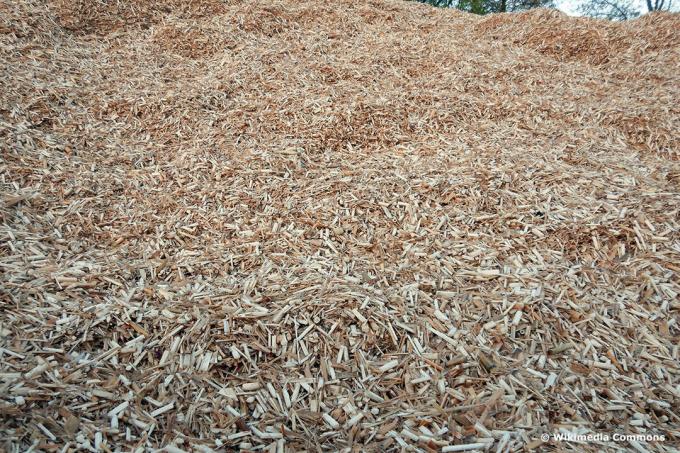
table of contents
- pH-neutral mulching alternative
- Effective against snails
- Effective against weeds
- Moisture storage
- Odorless mulch
- Long-lasting and economical
- Airy alternative
- Neutral shade
- Experiences with miscanthus mulch / chaff
- frequently asked Questions
Miscanthus chaff is increasingly being offered as an interesting alternative to mulching. What are the benefits of Chinese reed mulch compared to Bark mulch and Co., you can find out in this article.
In a nutshell
- PH-level neutral
- suppresses weed growth
- Snail protection
- stores moisture
- do not rot
pH-neutral mulching alternative
One of the greatest advantages of Miscanthus chaff, also known as elephant grass, is its pH neutrality. As a result, the mulch layer does not deprive the earth of oxygen, even if it remains on the ground for years. Bark mulch from conifers is often found in acidic soils and can therefore store toxic cadmium. The cadmium can then get into the soil of the bed and accumulate in your crops. This is not the case with Chinese reeds as a mulch alternative. Miscanthus chaff protect soils, in addition to cadmium accumulations, from the following problems that can arise from acidification:
- weak humus development
- bad soil structure
- Soils dry out faster
- washed out nutrients
- useful microorganisms die faster
- lower crop yields

Effective against snails
Miscanthus chaff has established itself as a snail protection due to its nature. The sharp-edged leaves are not pleasant for the mollusks and ensure that they do not move on the layer. It doesn't matter how thick the mulch layer is. Even in regions with a high number of snails, plants are protected by the mulch made from Chinese reeds.
Effective against weeds
As effective as against snails, Chinese reed is used to ward off weeds. The mulch forms a dense layer that does not allow airborne seeds to pass through. At the same time, it is a homogeneous raw material that is completely free of germs and seeds. This means that no unwanted seeds, seedlings, fungi or pathogens are brought into the bed. Miscanthus chaff can be used as an alternative to weed control.
Moisture storage
Miscanthus chaff have a high water storage capacity. The leaves absorb moisture and store it until it is needed. The water storage capacity enables a buffer during longer dry periods until watered or the weather improves again.
Odorless mulch
The smell of classic bark mulch is not pleasant for everyone. If you are looking for an odor-free alternative to mulching, the Miscanthus chaff are recommended. The shredded leaves are almost odorless, regardless of location, weather or age. The smell is reminiscent of straw and is usually only noticeable when spreading, if you touch the material directly with your nose.

Long-lasting and economical
You don't want to renew the mulch layer every year? In direct comparison to other types of mulch, micanthus mulch is much more durable because it rots slowly and remains robust during use. The silicon contained in the leaves has a moisture-repellent function, so that the green does not start to rot or go moldy. Even heavy rainfall and persistent soil moisture over a longer period of time are not a problem. The longevity ensures that the chaff is much more productive, as the mulch layer rarely needs to be renewed. A brief overview:
- Renew every 2 to 3 years
- switch outside of the growing season
- Spring or autumn ideal
- if necessary, refill individual positions throughout the year
Airy alternative
Due to the structure of the chaff, they loosen the soil over a longer period of time. Since the leaves are quite hard and do not lose their shape due to moisture, air constantly gets through the mulch layer to the soil. This has a positive effect on the nature of the soil, as the earth can breathe and supply the roots with sufficient oxygen. Plants that depend on an oxygen-rich and airy substrate receive a suitable basis for cultivation through the Miscanthus chaff.
Tip: Work some of the mulch into the soil in autumn to encourage the formation of humus. The green has an even better effect on the soil structure and ventilation.
Neutral shade
Classic bark mulch is often dark and for this reason cannot be easily integrated into the garden. Miscanthus chaff are kept in a light green shade that can be used inconspicuously for numerous corners and beds. If you prefer neutral colors for your beds, Chinese reed is much more suitable. Even large areas are less noticeable due to the natural green shade of the chaff.

Note: The color of the chaff reduces the heat generated on the ground by the sun's rays. Heat-sensitive plants can therefore be better protected from the sun by the grass mulch.
experiences with Miscanthus mulch / chaff
Both bark mulch and miscanthus chaff have decisive advantages. But which mulch you use for your garden depends on many factors. Many gardeners still swear by the traditional bark mulch. Benefit from the experiences that other hobby gardeners have already made with the miscanthus mulch. We have researched for you.
Note: For reasons of better readability, small spelling errors (spaces, reversed letters, etc.) have been corrected in the quotations. The exact sources are linked under the specification of the respective forum.
“As a trained but not a landscaper, I purposely bought the mulch. The elephant grass is a very effective C-4 plant and a great source of biomass. I wanted to get away from the damp, musty bark mulch in the garden that was dirty on clothes. We have a small 40 square meter garden in Vienna. Shady and humid, or blazing heat in the sun. Due to the location close to the Vienna Woods, we always have high levels of rainfall. The cattle mulch used up to now "gets drunk" and becomes mushy. This leaves indelible stains on children's clothing. The jumbo grass mulch is clean, light and has a pleasantly grassy-woody smell. In addition, it is free from splinters or Slates. The children love the new mulch. "
Source: www.amazon.de; User: nuray karakurt; Date: March 19, 2019
“The snails are based on the assumption that they don't like to crawl over sharp-edged leaves. In practice, however, you don't have to tell the snails until you collect them from the mulch.
Doesn't acidify the soil? Just because the mulch itself is pH-neutral doesn't have anything to do with how it reacts to the soil. When rotting, acids are always formed, and the humus that forms also binds lime in the soil, so it always gets acidic when you mulch.
What about the nitrogen balance of the miscanthus mulch? Smell, spread, fly away, minimum layer thickness: where is the advantage compared to straw or wood shavings? You can get them cheaply in larger quantities. With 2000 square meters and 5 cm of mulch thickness, it would be mathematically up to 10 cubic meters of mulch that would be needed. "
Source: www.forum.mein-schoener-garten.de; User: Yersenia; Date: December 01, 2010
“A great thing about this elephant grass! The plants (tomatoes, peppers, ginger, ...) that I covered with them are thriving. I think it's because it doesn't dry out the earth, especially the surface. It doesn't go moldy despite watering. However, some grass-like grain grows from it? Or does the elephant grass look like this in its raw state? But that's not a point deduction as it's not a problem. I poured it into plastic buckets so that I could keep it dry with the lid. I will definitely continue to use it and can definitely recommend it. "
Source: www.amazon.de; User: ADC; Date: 07/24/2019
“For some, this type of mulch is difficult to find in Germany. Yeah, it's a bit expensive. But it works very well and looks great.
Source: www.amazon.de; User: Maddy Ross; Date: 03/25/2021
It keeps the soil below moist and adds that protective layer to the top soil. I think it will last a very long time. "
frequently asked Questions
Miscanthus mulch is applied in a layer five to six centimeters thick for the best effect. With this layer thickness, the chopped Chinese reed shows its advantages during use. The mulch layer doesn't have to be thicker.
Wear gloves as a precaution, as miscanthus species have sharp-edged leaves. Once chopped up, these can still result in cuts if they are spread out. You should also moisten the mulch layer well after application. This prevents the chaff from being blown away due to its low weight.
Yes, the chaff can easily be used as ground cover during the cold season. For this purpose, the already mentioned layer thickness is used, through which the soil and the plants are protected from frost. Even on damp winter days, the Chinese reed provides good protection for the plants.


